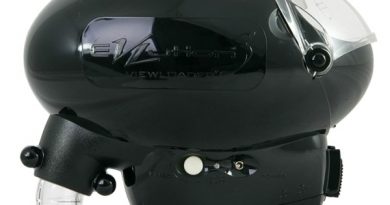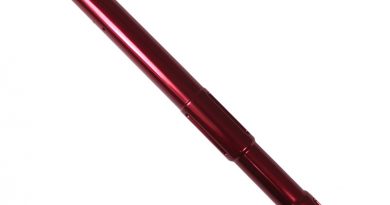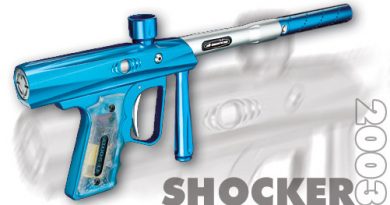Dragun TES Marker Review
By Andrew C. Syren and Kevin Cappon
It would seem that in the tournament scene today you would not survive without a marker setup worth well over one thousand dollars. Well, today I am here to say that the days of needing an expensive marker to compete in the tournament scene are officially over.
Enter the Dragun.

Dragun Empire has created a line of inexpensive markers that will not only compete with the high end markers of today but will become key components in aiding young players with less money into the tournament scene. The Dragun T.E.S. (Tactical Electronic Sniper) was the marker selected for review from Dragun Empire.
This exclusive review will discuss the appearance, packaging, functionality of the marker on and off the field, and the ease of maintenance. During the review of this marker my assistant and I were able to run through some rigorous maneuvers on a tournament field supplied to us by TC Paintball in Grand Rapids Michigan home of the TCP Xtrene Autococker.
Firstly, the appearance of the Dragun T.E.S. is amazing. Right from the start, I was impressed with how well the anodizing looked. The body was smooth showing no signs of blemish. This is impressive to me since with most lower end markers, there’s a lot to be desired when it comes to the uniqueness of the marker’s outward appearance.
One could consider this marker a Spyder clone and would be correct as far as the internal workings go, but the external appearance of this marker presents itself as much more. From the well-balanced fade in the anodize to the Anti-Chop Eye cover, this marker comes across as a much more sophisticated paint slinger.
Other positive aspects of the marker’s looks were the matte finish on the feed neck, ball detent, eye cover and the regulator ASA. The black accents were intended for cost saving but don’t take away from the overall look of the marker. To say that this marker was absolutely the end all marker for looks, would be an overstatement, but in the end, this marker is a prime example of what a Spyder clone should look like; well-balanced looks with a sturdy feel.
Actually holding the marker was what made me gain further respect for it. In your hand it has a solid feel, unlike so many cheaper low-end markers. The grip frame was solid and felt as though it were made for a larger set of hands suggesting that this marker was built with the larger player in mind. To sum up the feel of the marker in a few words, I would have to say that the marker was a far cry from the low-end tinker toy markers that can be found for roughly the same price.
The Dragun T.E.S. also comes in very nice packaging. The marker comes in a standard black plastic case with foam padding to protect your investment. The case has two clasps to close it and looks as though it could withstand a 30-foot drop off any tree stand. This is a great deal, considering that a similar case would cost over 20-30 dollars and would not come with the Dragun T.E.S. logo on it.
Included in the packaging of the marker were a couple extra o-rings for the bolt and the proper allen wrenches to complete any adjustments described in the manual. Also included were a few small plastic eye protector shields that fit between the anti-chop eye and the breech to keep the eye from ever being too soiled when any oil is worked through the markers internal workings.
For added safety, Dragun Empire also includes a barrel plug and should be used at all times when the marker is gassed up or loaded with paint. The packaging of this marker suggested to me that Dragun Empire was proud of their markers and wants you to feel that for the low price you pay your getting your penny’s worth.
The functionality to any marker is described in the way the marker shoots on the field and at the chronograph. After loading up the marker with HPA and using TC Venom paint we headed to the chrono. Firing the marker over the chrono we found a small and impressive deviance of less than 2 fps (feet per second). I believe that the chronograph results were a direct result of several properties such as the marker coming stock with a high flow regulator and the high flow valve assembly coupled with the use of the HPA supplied to us by TC Paintball, and the paint to barrel match.
Chronograph results like these are generally found in most high-end markers such as Angels and Autocockers. Considering that the T.E.S. costs less than one fourth of the cost of most high-end paintball markers, these results were astonishing.
On the field, testing the distance shot as well as tightness of groupings done with snapshooting, we found that this marker presented itself as a deadly adversary to any opponent. Through a rigorous battery of testing and 2000 rounds of paint the results of the Dragun T.E.S. were extremely exciting.
We found that the average grouping shot from a distance of about 20 feet was within the 3 to 5 inch margin. The task of snapshooting with the T.E.S. was easily done and the lightweight feel of the marker made running from bunker to bunker a simple feat. We also tested the marker in a ‘back player’ style of play and found that laying a steady stream of paint with little to no breaks was as easy as pie.
The 13 balls per second was a breeze with this marker and setting the marker to 20bps simply embarrassed my 12 volt VL Revolution. Some of the posh features on this marker were the lightweight aspect of the marker and the anti-chop eye that comes standard.
With the eye we found it nearly impossible to chop any paint whatsoever. The only paint found to have trouble was the darker paintballs as the eye is a photo eye rather than a beam break eye. Turning the eye off was not something mentioned in the manual so we initialy thought that the user was unable to turn the eye off for test firing the marker. Later however we found through an internet source that the eye was capable of being turned off. It can be turned off by simply turning the gun on then holding the trigger down for 10 seconds. Some sources say 8 seconds, some say 15 so we later tested the data found and discovered that 10 seconds was ample time while holding the trigger down to deactivate the eye on the T.E.S.
They eye, regardless of it’s shortcomings as a photo eye rather than a beam break eye was a wonderful factory upgrade and in the time we took to review the marker we had one single breach break due to our tank being too low on air and about 5 barrel breaks that were cleaned out after about 5 to 7 shots. Barrel breaks can be cured by the purchase of a barrel kit such as the Empire Barrel kit or the CP Barrel kit. Both are personal recommendations of my assistant Kevin Cappon and myself.
Functionally, the smooth trigger movement and the ease of the LCD menus made this marker stand out. The trigger can be adjusted by a small allen screw inside the trigger frame. By removing the trigger frame from the marker the screw can be seen and easily adjusted to make the pull of the trigger very short.
After adjusting the trigger we found that walking the trigger was easy, but still had a tougher pull to it than your higher end markers. The LCD screen was rather nice, large and easy to read. Running through the menu was easily accomplished and the buttons were a perfect size for fingers outside of wearing gloves. After we were extremely satisfied with the testing of the marker on the field and at the chronograph we decided to head back to the shop and tear into the marker to see how well the internals held up.
Disassembling the marker is done with the greatest of ease, as it resembles that of a Spyder. Pulling the rear pull pin out the internals simply slide out and can be oiled with ease. Looking over the hammer and bolt we found minor wear on the bolt butt.
Overall, this is an excellent marker and everyone should get one.




